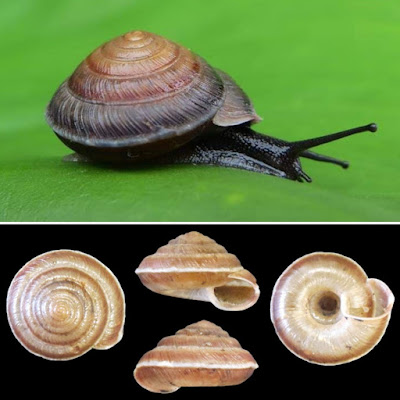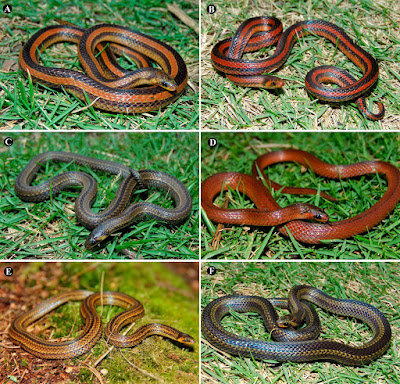[Most Recent Entries] [Calendar View]
Friday, May 10th, 2019
| Time | Event | ||||||
| 2:58a | [Botany • 2019] Allium sultanae-ismailii (Amaryllidaceae) • A New Species from eastern Turkey
Abstract Allium sultanae-ismailii Yıldırım (Amaryllidaceae) is described here as a new species. Diagnostic morphological characters, a full description, and detailed illustrations are given herein. A. sultanae-ismailii is restricted to Mt. Akbabaçalı in Darende district of Malatya province in eastern Anatolia, Turkey. According to its morphological features, it belongs to Allium subgen. Melanocrommyum sect. Melanocrommyum. It shows morphological similarities with A. purpureoviride, which belong to the same subgenus and section. However, it is easily distinguished from this latter species by the dark purple tepals, shorter stem, initially stellate perianth segments, longer style, undivided and very short tripartite stigma, and distribution at higher altitudes. Keywords: Monocots, eastern Anatolia, Malatya province, subgen. Melanocrommyum, taxonomy Hasan Yıldırım. 2019. Allium sultanae-ismailii (Amaryllidaceae), A New Species from eastern Turkey. Phytotaxa. 403(1); 39–46. DOI: 10.11646/phytotaxa.403.1.3 | ||||||
| 8:19a | [Gastropoda • 2019] Landouria strobiloides • First Verified Record of the Genus Landouria Godwin-Austen, 1918 (Stylommatophora: Camaenidae) from Thailand with Description of A New Species
Abstract A new species of land snail is described from the Suan Hin Pha Ngam Limestone Area in Loei Province, northeastern Thailand. This species is placed in the genus Landouria Godwin-Austen, 1918 based on the presence of a slightly long club-shaped flagellum with variably sized tubercles, a gametolytic sac with swollen basal part, and absence of dart sacs and mucous glands. This is the first verified record of the genus Landouria in Thailand. Key words. new species, Landouria, Aegista, Thaitropis, reproductive anatomy, Loei Province, Thailand
Superfamily Helicoidea Rafinesque, 1815 Family Camaenidae Pilsbry, 1895 Genus Landouria Godwin-Austen, 1918 Landouria strobiloides, new species Diagnosis. Body whorl of shell with very sharp keeled, aperture slightly thickened and with a reflexed rim. Flagellum slightly long, club-shaped, with variably-sized tubercles. Base of gametolytic sac enlarged and swollen. ... Etymology. The specific epithet strobiloides derived from the strobilus, referring to the flagellum of the new species, which looks similar to the strobilus of non-flowering plants because it possesses many tubercles on its surface. Remarks. The genitalia of the new species agree in general detail with the genital anatomy of congeneric species, but it has the longest tubercles on the flagellum within the genus. The anatomy of Landouria differs from Aegista by the absence of a well-developed dart sac, lateral accessory sacs, and mucous glands (Schileyko, 2004). In Thailand, the snails that have the last whorl slightly descending in front and large umbilicus were assigned to Aegista, but this needs to be confirmed by a study of their anatomical characters. Chanidaporn Tumpeesuwan and Sakboworn Tumpeesuwan. 2019. First Verified Record of the Genus Landouria Godwin-Austen, 1918 from Thailand (Gastropoda: Stylommatophora: Camaenidae) with Description of A New Species. RAFFLES BULLETIN OF ZOOLOGY. 67; 298–305. lkcnhm.nus.edu.sg/app/uploads/2018/11/RB Takahiro Hirano, Yuichi Kameda, Kazuki Kimura and Satoshi Chiba. 2014. Substantial Incongruence Among the Morphology, Taxonomy, and Molecular Phylogeny of the Land Snails Aegista, Landouria, Trishoplita, and Pseudobuliminus (Pulmonata: Bradybaenidae) occurring in East Asia. Molecular Phylogenetics and Evolution. 70; 171-181. DOI: 10.1016/j.ympev.2013.09.020 | ||||||
| 9:29a | [Herpetology • 2019] Atractus marthae • A New Polychromatic Species of Atractus (Serpentes: Dipsadidae) from the Eastern Portion of the Colombian Andes
Abstract We describe herein a new polychromatic species of the snake genus Atractus from the cloud forests of the northeastern Andes of Colombia. The new species is distinguished from all congeners by having an exclusive combination of phenotypic characters, such as: dorsal scale rows 17, loreal long, seven to ten maxillary teeth, ventrals 156–174 in females and 153–169 in males, subcaudals 20–30 in females and 23–30 in males, dorsum with variable coloration, changing from dark green to orange or red with a black nuchal band (three to four scales long) connected to a black vertebral line and two black dorsolateral continuous stripes from the occipital region to tip of the tail, venter with irregular black blotches, relatively small body size, small tail length in females and moderately long in males, hemipenis moderately bilobed, semicapitate and semicalyculate. We compared the new species with all congeners occurring along the Cordillera Oriental in Colombia, Sierra de Perijá in the Colombia/Venezuela frontier and Cordillera de Mérida in Venezuela. We discussed aspects related to polychromatism and its implication toward a robust taxonomy for the genus Atractus.
Atractus marthae, new species Martha’s Groundsnake, Culebras Tierreras de Martha Etymology.— The new species is named herein in honor of Martha Patricia Ramírez-Pinilla for her invaluable contribution to the knowledge of the biology of Colombian amphibians and reptiles. Furthermore, we would like to acknowledge her dedicated vocation as a professor at the Universidad Industrial de Santander, during which she has contributed to the formation of many generations of herpetologists. Distribution.— Atractus marthae is known from three localities in the western slope of Cordillera Oriental, department of Santander, Colombia. ... Elson Meneses-Pelayo and Paulo Passos. 2019. New Polychromatic Species of Atractus (Serpentes: Dipsadidae) from the Eastern Portion of the Colombian Andes. Copeia. 107(2); 250-261. DOI: 10.1643/CH-18-163 Describimos una nueva especie de serpiente policromática del género Atractus para los bosques nublados del noreste de los Andes de Colombia. La nueva especie se distingue de todos los congéneres por tener una combinación exclusiva de caracteres fenotípicos, como: escamas dorsales en 17 hileras, loreales largas, siete a diez dientes maxilares, ventrales 156–174 en hembras y 153–169 en machos, subcaudales 20–30 en hembras y 23–30 en machos, dorso con coloración variable, cambiando de verde oscuro a naranja o rojo con una banda nucal negra (largo de tres o cuatro escamas) conectada a una línea vertebral negra y dos franjas continuas dorsolaterales negras desde la región occipital hasta la punta de la cola, superficie ventral del cuerpo con manchas irregulares negras, tamaño corporal relativamente pequeño, longitud de la cola pequeña en las hembras y moderadamente larga en los machos, hemipene moderadamente bilobado, semicapitado y semicaliculado. Comparamos las nuevas especies con todos los congéneres que ocurren a lo largo de la Cordillera Oriental en Colombia, Sierra de Perijá en la frontera de Colombia/Venezuela y la Cordillera de Mérida en Venezuela. Discutimos aspectos relacionados con el policromatismo y su implicación hacia una taxonomía sólida para el género Atractus. | ||||||
| 10:11a | [Herpetology • 2019] Ikakogi ispacue • The Poverty of Adult Morphology: Bioacoustics, Genetics, and Internal Tadpole Morphology reveal A New Species of Glassfrog (Anura: Centrolenidae) from the Sierra Nevada de Santa Marta, Colombia
Abstract Ikakogi is a behaviorally and morphologically intriguing genus of glassfrog. Using tadpole morphology, vocalizations, and DNA, a new species is described from the Sierra Nevada de Santa Marta (SNSM), an isolated mountain range in northern Colombia. The new taxon is the second known species of the genus Ikakogi and is morphologically identical to I. tayrona (except for some larval characters) but differs by its genetic distance (14.8% in mitochondrial encoded cytochrome b MT-CYB; ca. 371 bp) and by the dominant frequency of its advertisement call (2928–3273 Hz in contrast to 2650–2870 Hz in I. tayrona). They also differ in the number of lateral buccal floor papillae, and the position of the buccal roof arena papillae. Additionally, the new species is differentiated from all other species of Centrolenidae by the following traits: tympanum visible, vomerine teeth absent, humeral spines present in adult males, bones in life white with pale green in epiphyses, minute punctuations present on green skin dorsum, and flanks with lateral row of small, enameled dots that extend from below eye to just posterior to arm insertion. We describe the external and internal larval morphology of the new species and we redescribe the larval morphology of Ikakogi tayrona on the basis of field collected specimens representing several stages of development from early to late metamorphosis. We discuss the relevance of larval morphology for the taxonomy and systematics of Ikakogi and other centrolenid genera. Finally, we document intraspecific larval variation in meristic characters and ontogenetic changes in eye size, coloration, and labial tooth-rows formulas, and compare tadpoles of related species. Ikakogi tayrona has been proposed as the sister taxon of all other Centrolenidae; our observations and new species description offers insights about the ancestral character-states of adults, egg clutches, and larval features in this lineage of frogs.
Ikakogi ispacue sp. nov. Diagnosis: Ikakogi ispacue sp. nov. can be distinguished from other centrolenids (the only exception is I. tayrona) by having a slightly sloping snout, rounded lateral profile; a tympanum that is not visible; humeral spines in adult males; vomerine teeth absent; parietal peritoneum 1/2 white; green dorsum with black punctuations along the dorsal surfaces and a flanks with a lateral row of small enameled dots that extends from below the eye to just posterior to the insertion of the arm; color of bones in life white, but with a pale green coloration in bone epiphysis; color in preservative uniformly very pale lavender to cream. .... Natural history: Males and females were observed in subtropical forest perched on the vegetation at heights of 1–2 m. (Fig 4). Males were observed calling from the lower and upper surfaces of leaves along streams at height of 50–350 cm approx. (Fig 4A). Females deposited and cared for egg clutches (referred to the species by association with their mothers perched on clutches) on either the upper side or lower side of leaves overhanging streams (ca. 50–100 cm; Fig 4B). Clutches contained uniformly pale cream or pale green eggs (n = 4; 55 ± 6.21; 48–62 eggs; Fig 4B). The morphology of the egg mass observed near males of I. ispacue sp. nov. is a monolayer mass lacking eggs and jelly in the center of the clutch, which gives an appearance of a "ring" shape (n = 3; Fig 4C). Embryos exhibit cranial hypervascularization, which turned their color reddish or pink; the heart is translucent but colored reddish by blood. Tadpoles of Ikakogi ispacue sp. nov. were found buried in fallen leaves and sand in small pools (area = 1–2 m2; depth = 30–50 cm) located along the edge of streams. ... Etymology: The specific epithet originates from the Kogi words “tshi” and “spákue”, meaning “twin of”. The word is used as noun in apposition and refers to the high similarity and presumed close relationships of the new species and Ikakogi tayrona. Marco Rada, Pedro Henrique Dos Santos Dias, José Luis Pérez-Gonzalez, Marvin Anganoy-Criollo, Luis Alberto Rueda-Solano, María Alejandra Pinto-E, Lilia Mejía Quintero, Fernando Vargas-Salinas and Taran Grant. 2019. The Poverty of Adult Morphology: Bioacoustics, Genetics, and Internal Tadpole Morphology reveal A New Species of Glassfrog (Anura: Centrolenidae: Ikakogi) from the Sierra Nevada de Santa Marta, Colombia. PLoS ONE. 14(5): e0215349. DOI: 10.1371/journal.pone.0215349 |
| << Previous Day |
2019/05/10 [Calendar] |
Next Day >> |





